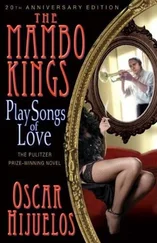“Compañeros, amigos, damas y caballeros,” the host excitedly began. “I hope you are enjoying this lovely morning, and speaking of loveliness, for true beauty is never subject to the castigations of age, with us today is the one and only María Rivera, as she called herself for the stage… If this name does not immediately ring any bells with my younger listeners, please go ask your abuelos-your grandfolks-about the 1956 bolero the original ‘Beautiful María of My Soul,’ a cherished song from la Cuba que fue. As my listeners know, we have been up to our necks with other Marías lately-what imaginations some of you ladies have!-but our visitor today, a most elegant and well-preserved woman, surely beautiful, has presented the station with undeniable proof of her claims-mainly letters from Nestor Castillo himself, and some wonderful photos that, well, it breaks one’s heart to see, for this couple was obviously in love.”
Turning his chair towards her and raising a hand as a cue, he said: “Señora María García, muy, muy buenos días, and thank you for coming on this show. So now, we can begin, yes?”
“Sí, señor.”
But before she could say anything, he started reading from a sheet.
“A longtime resident of Miami, María García y Cifuentes hailed originally from our beloved province of Pinar del Río and moved to Havana proper during that city’s golden age, in the late 1940s. There, she was a popular figure in the Havana club scene as a dancer.” (He cleared his throat, seemingly suffering from a cold.) “Performing in some of the best clubs in those heady days before the greatest debacle of Cuban history took place, she also fell passionately in love with the composer of that most famous song. She, the one and only beautiful María herself, is here today to tell us her story.”
María did not say a word for a few moments, the host prompting her. And then, for the next seven minutes, until a commercial break, she spoke slowly, serenely about her valle, her papito, and the little tragedies that led her to Havana even while the program’s host, seemingly exasperated at times, kept interjecting, “But tell us, señora, about Nestor Castillo!”
She finally did, shrugging. “When I met Nestor, on the street where I lived in Havana, he just reminded me of those pure souls I knew from my childhood, the kind of fellow who would never hurt anyone intentionally-he was a romantic sort, loved to sing to me, loved to dream aloud in my presence.” She sipped from a cup of water. “I knew no one else like him. He treated me as if I were made of gold, loved me as if there were no tomorrow-why I let him go to America without me, I cannot say. But he was the one, as the old songs say, who got away.”
Then commercials, and the host, fearing that the segment might be dragging, took another approach. “Now that we’re back, may I ask you a question about the movie, which I understand you’ve seen?”
“Of course.”
“How did that feel to see yourself depicted on-screen?”
She shrugged. “It was okay. I liked the actress who played me well enough-a lovely muchacha. But it wasn’t me, you understand. I just wish that someone would one day make a real story about us Cubans, by Cubans, for this country to see, entiendes?”
And that was all. Thanking María, the program’s host, disappointed in his hope for a saucy story or two, bade her well and reminded his audience that they had just been listening to the real beautiful María, and to please refrain from further calls about the matter of her identity. As a concession to her appearance, he plugged her dance studio in Miami and made sure that she and Teresita left with two coffee mugs, emblazoned with the station’s logo. On the drive back, María did not have much to say about the experience, except that she felt as if she had been trapped in a jar or, more graphically, that someone had shoved a dedo-a finger-up her fundillo- her ass.
“But, Mama, it was you who wanted to go on that show.”
“I know,” María told Teresita. “I was angry that so many women were claiming to be me. But you know what? Even as I sat there talking to that very nice man, I got the feeling I was wasting my time. None of us can go back. All those memories are what? Just little dreams.”
Nevertheless, from that single radio interview, a lot of people became interested in the real María. El Nuevo Herald, stoking the nostalgic embers of its Cuban audience, did a feature article about her for its Sunday Arts supplement. A photograph of a much younger María, her shapely body posed upon a couch-size magenta seashell in one of those glittering showgirl’s outfits, with a ridiculously high plumed fake-gem-studded hat piece balanced precariously atop her head, appeared on the front page. And, while they had provided a brief, more or less accurate biography of her life, along with some quotations, to María’s greater satisfaction, they had ended the piece with one of the verses she had written in Luis’s class: “If Cuba Were a Man.” Cristina Saralegui, who had a very popular talk show on the Univision network, invited María on her program, and while María was most flattered by her interest, she felt too intimidated about appearing on camera and (possibly) shattering her image as an eternal beauty, so she reluctantly refused. Even Don Francisco, of Sábado Gigante, had someone on his staff call María to ask if she would be willing to attend a filming of his program out of Miami, just so he could introduce her from the audience. This she almost did but changed her mind at the last minute, suffering from a terrible headache, or so she claimed. But she agreed to appear alongside the actress Talisa Soto in a print advertisement for Europa perfume, shot in South Beach for a promotion about the “Two Marías, eternally graceful and fragrant.” (The actress was very nice, and María liked the fact that Ms. Soto had brought along her charming Puerto Rican mother, and the fact that she, doted over and dressed up in a wonderful gown, did not come off badly in the photographs and was paid a two-thousand-dollar fee for her troubles.)
And in her neighborhood? From just that smattering of publicity, she became a most notable figure; a lot of folks along her street who never used to, suddenly invited María and Teresita in for Sunday dinners. (These she did not mind.) If there occurred any alarming incidents, they had to do with jealousy, when some women, recognizing her in downtown Miami, glanced at María enviously, as some used to back in Havana, and her notoriety induced more men, usually much older ones, to stare at her hopefully, though rarely with lust. (She had even been approached for autographs again!) This lasted for about six months, and in that time as a local celebrity, a silly period as far as Teresita was concerned, beautiful María rarely ventured from her home without putting on a pair of large black sunglasses, even at night, as if she were a movie star, and she had taken to wearing an enormous sunhat by day, with a florid silk scarf tied around its brim, its length trailing unmistakably behind her as if it were the tail of a kite.
But for all of that, and despite the fact that at least people now recognized her as the María of that song, María made the discovery that she simply didn’t care about being better known. Her past life with Nestor, despite that song, that novel, that movie, was most splendidly preserved in the realm of her own memories.
What mattered to her the most? Her daughter, and her motherly concerns over Teresita’s tepid and unromantic existence. While Teresa hardly paid attention to that notion, her workweeks proceeding routinely as before, María’s own love life hadn’t turned out too badly. Once she got used to the idea of Luis, despite his plainness, his bony body, his pocked, unsymmetrical face-those eyes that always seemed to be rheumy behind wire-rimmed glasses-she fell in love with another side of him. In fact, after a while, as in a fairy tale, the more beautiful María looked at Luis, the more his homeliness began to fall away. Though he seemed hardly anything like the handsome Nestor Castillo, with his liquid, soulful eyes, María, after so many years of general indifference to men and of few expectations, came to think of that Ichabod Crane-looking Cuban as somewhat handsome. And, in time, given the little comforts she extracted from his presence, María ached more for his company.
Читать дальше












